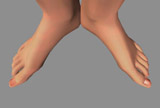Intro to Hip Motion
Technical Tips
Maximizing Your Motion
In order to get the most from your hip motion, the following technical points should be observed:
Poise forward.
The body weight should always be held forward towards
the balls of the feet in the Latin dances. This helps facilitate the
rotational action of the hips around the spine.

Use turnout.
Turning your feet out is an essential element in producing effective hip motion. Not
only does it provide a more stable base over which the body can balance, but
the feet themselves tend to be more visually appealing. Most importantly, the
turnout of the feet increases the range of motion of your hips. Since our goal
is to maximize the rotation of the hips around the spine, more turnout is
better.
Bend knees inward.
The natural position of the knees causes them to bend at the same angle as the feet.
Since your feet are (presumably) turned out, you will have a natural tendency to bend
the knees outward at the same angle. But believe it or not, bending the knees outward
is actually undesirable because when you do so, you limit the range of motion of the
hips. More specifically, you limit the amount to which the opposite hip can rotate
backwards. So when you bend the knee, try to always bend it inward, toward the direction
of the straight leg.
Roll to the inside edges of the feet.
In order to bend the knee inward while your feet are turned out, the foot underneath
the bent knee should roll to the inside edge. If your foot has not rolled to the inside
edge, then either the knee has not bent inward, or the feet have not maintained turnout.
Push the knee straight back.
When practicing hip action, do not neglect the importance of the straight leg. It is a
very common mistake to focus so much on the bent knee, that the opposite knee does not
straighten as it is supposed to. This prevents the hip from rotating backwards. In order
to get the maximum angle and rotation from your hips, you should try to actually push the
straight leg backwards. The hip over the straight leg will push backwards, too.
Isolating The Hips
Keep the shoulder line level.
Do not pitch or sway the entire body. When the angle of the hips changes, you must
compensate by lengthening and shortening the appropriate sides of the torso so that the
shoulders remain level. The side of the torso over the bent knee must stretch and
lengthen, while the side of the torso over the straight knee must squeeze and shorten.
Don't rotate the shoulders with the hips.
The upper body is to remain steady and isolated from the movement of the hips. When the
hip over the straight leg rotates backward, at the same time try to rotate the upper
back in the opposite direction to help maintain their position.

